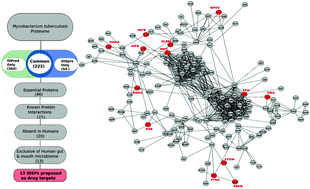Many eukaryotic and prokaryotic proteins remain disordered under physiological conditions and often acquire a stable secondary structure on binding to their cellular targets. Though the process of binding is still under analysis, it has been found that the flexibility of proteins can add to their functionality. This motivated us to explore intrinsically disordered proteins (IDPs) as drug targets. In silico studies have been carried out on Mycobacterium tuberculosis, which, with emergence of hyper-virulent and drug resistant strains, XDRs and MDRs, is one of the most dreaded pathogens in the modern world. Our study reports 13 IDPs as potential drug targets, and three of them—FtsW (Rv2154c), GlmU (Rv1018c) and Obg (Rv2440c)—are chosen as key proteins and are described in detail. Future applications of this method can provide new insight into understanding the molecular mechanism of IDPs and their potential role as drug targets.
You have access to this article
 Please wait while we load your content...
Something went wrong. Try again?
Please wait while we load your content...
Something went wrong. Try again?


 Please wait while we load your content...
Please wait while we load your content...